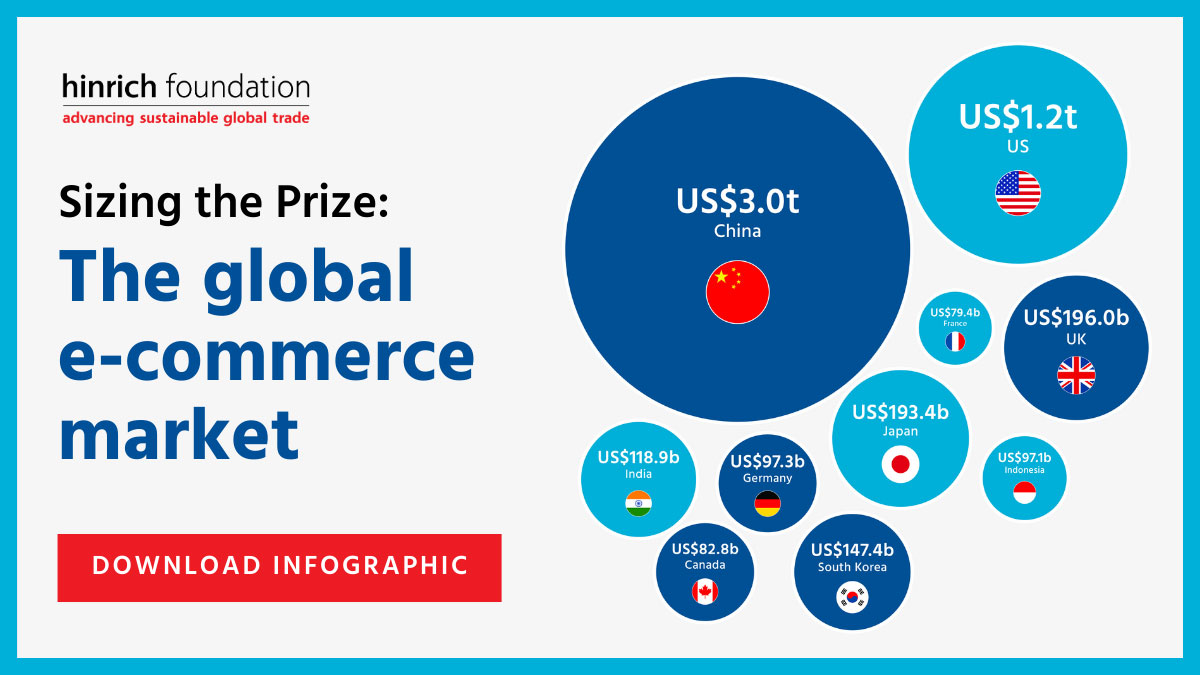Published 09 January 2024
As the global economy faces headwinds going into 2024, our infographic profiles the world’s US$6 trillion e-commerce market, one of the few remaining drivers of global growth.
Even as global trade slows, e-commerce is still surging, outpacing merchandise goods by twice the level of export growth in 2022. Digitally delivered services, a key segment of the market, rose nearly four times in value since 2005, according to World Trade Organization data.
Despite long-running failure among policymakers around the world to agree on how to regulate this crucial engine of global economic growth, the global e-commerce market remains crucial for micro, small, and medium-sized enterprises (MSMEs) as a new opportunity to join in global trade. This brings inclusive economic development especially to developing economies.
What does the market look like? Our long-form infographic Sizing the Prize: The global e-commerce market, co-designed by Singapore-based illustrator Daniel Chan, profiles its value and projected 9% compounded annual growth rate through 2027. It shows that e-commerce, despite ongoing government policies enacted or attempting to tax digital trade, is poised to capture some 41% of global retail sales by 2027, more than double the rate a decade earlier.
Download Sizing the Prize: The global e-commerce market by Hinrich Foundation:

China remains the world’s largest e-commerce market worth some $3 trillion, trailed by the US, Britain, Japan, and other major economies particularly in Europe and Asia. The fastest-growing e-commerce markets, as our research shows, are concentrated in the Asia-Pacific region, led by the Philippines, and followed in order by India, Indonesia, Malaysia, and Thailand.
As our Research Fellow Kati Suominen has shown, the e-commerce boom drives benefits beyond balance sheets, opening up new avenues for participation in the work force by non-traditional societal groups such as women and leveling the playing field for the financially less-advantaged.
The market reveals the taste and direction of global consumers. Fashion is the highest-grossing e-commerce sector, closely followed by consumer electronics. Food is the world’s fast-growing e-commerce sector, the infographic shows.
Sizing the Prize also reveals some surprising factoids: While Amazon.com still rules the planet in e-commerce, America’s next largest e-commerce companies increasingly are offshoots of their brick-and-mortar parents – retail giants such as Home Depot, Costco, and Walmart. In China, tech behemoth Alibaba Group still dominates, while industrial conglomerate Reliance Retail has followed the American tack by successfully morphing its platform to dominate the Indian e-commerce space.
The graphic also profiles how e-commerce shoppers and buyers behave: how often they buy, what devices they use, and why they abandon their shopping carts.
As the global digital trade policy landscape becomes increasingly fragmented, buffeted by geopolitical tensions and climbing trade costs, e-commerce remains a critical opportunity for global growth and MSMEs.
© The Hinrich Foundation. See our website Terms and conditions for our copyright and reprint policy. All statements of fact and the views, conclusions and recommendations expressed in this publication are the sole responsibility of the author(s).
Related Articles

E-commerce and LDCs: The different speeds of greater integration
21 November 2023

Digital technology and global integration: Opportunities for innovative growth
11 October 2022

China's ambitions to set the foundations for global e-commerce
01 March 2022

The greater good: Eight challenges to the global e-commerce boom
07 November 2023

E-commerce and LDCs: The different speeds of greater integration
21 November 2023

Digital technology and global integration: Opportunities for innovative growth
11 October 2022

China's ambitions to set the foundations for global e-commerce
01 March 2022

The greater good: Eight challenges to the global e-commerce boom
07 November 2023

E-commerce and LDCs: The different speeds of greater integration
21 November 2023

Digital technology and global integration: Opportunities for innovative growth
11 October 2022

